CHAPTER 1 Introduction
1.1 OPM3®—Organizational Perspective
Successful implementation of a new organizational strategy can turn a good organization into a great
one. Conversely, strategies that fail or generate poor results can quickly damage the organization’s
reputation and brand, internally and externally. Effective strategy execution is the responsibility of all
levels of management, who must be involved actively and consistently to orchestrate required organ-
izational changes and to manage the portfolio of investments that underpin these change initiatives.
The Organizational Project Management Maturity Model (OPM3) provides an organization-wide
view of portfolio management, program management, and project management to support achieving
Best Practices within each of these domains. This holistic perspective is a powerful tool enabling suc-
cessful execution of organizational strategies, portfolios, programs, and projects, especially when these
transcend functional and hierarchical boundaries. Moreover, OPM3 global Best Practices, applied to
the execution of strategy, can drive superior and sustainable results. These Best Practices are fully
aligned with all other PMI standards, including the A Guide to the Project Management Body of
Knowledge (PMBOK® Guide)—Fourth Edition, The Standard for Program Management—Second Edi-
tion, and The Standard for Portfolio Management—Second Edition. The OPM3 Best Practices are also
compatible with other global standards relating to projects, programs, and portfolios.
The OPM3 Knowledge Foundation describes the most important components of PMI’s Organiza-
tional Project Management Maturity Model. This document also describes how to plan for organiza-
tional improvements through the systematic acquisition of Best Practices in the management of portfo-
lios, programs and projects. Figure 1-1 provides a high-level view, showing the major components
within OPM3. These are summarized in the following sections and described in more detail throughout
the remaining chapters of the OPM3 Knowledge Foundation.
�
Figure 1-1. High-Level OPM3 View
1.2 Strategy Execution
OPM3 identifies key leverage points that represent interactions between organizational governance,
strategy execution, and project, program, and portfolio delivery. By understanding and using these lev-
erage points, an organization can methodically pursue its strategic goals through portfolios, programs
and projects and achieve the desired organizational outcomes.
As illustrated in Figure 1-2, organizational governance is the driving force that oversees the at-
tainment of organization-level goals and strategies through portfolios, programs and projects. These
efforts are enabled through overarching organizational structures, policies, procedures, and other gov-
ernance mechanisms. OPM3 contains governance-related Best Practices designed to guide the organi-
zation to identify and select those kinds of projects that will support strategy execution.
OPM3® – Second Edition
Page2 of 79
�
Figure 1-2. Organizational Leverage Points
During execution, the organization actualizes, or puts into action, its strategic planning decisions,
and allocates resources to authorized portfolio investments. OPM3 contains Best Practices designed to
ensure that the organization executes its strategy through initiatives and investments that can best sup-
port the achievement of its goals. The aim of project portfolio management is to guide investment de-
cisions, provide decision-making transparency, and increase the likelihood of realizing the desired re-
turn on investment. Enveloping all investments within a portfolio enables the organization to consider
comprehensively its project/program investments to ensure that these address strategic objectives and
interdependencies between projects. OPM3 contains Best Practices designed to help an organization
identify the appropriate mix of investments that best meets its execution strategies.
1.3 OPM3 Components
Organizations can benefit from the OPM3 Best Practices, which were identified in and gathered from
public- and private-sector organizations throughout the world. These Best Practices are core compe-
tencies and organizations that adopt them are more likely to execute their strategies successfully.
OPM3 Best Practices in portfolio, program, and project management can help an organization attain its
strategic objectives and achieve organizational excellence in a consistent and reliable manner.
OPM3® – Second Edition
Page3 of 79
�
As depicted in Figure 1-3, there are two categories of OPM3 Best Practices - SMCI [standardize,
measure, control, and continuously improve] Best Practices and Organizational Enablers. SMCI Best
Practices are classified by stage of maturity within the domains of portfolio, program, and project
management. Organizational Enablers (OE) are structural, cultural, technological, and human-resource
Best Practices that underpin the implementation of SMCI Best Practices. The relative position of Or-
ganizational Enablers in Figure 1-4 portrays their foundational role in the adoption of SMCI Best Prac-
tices because they both anchor and sustain advances in organizational maturity.
Figure 1-3. Improving Organizational Performance
Whereas Figure 1-1 illustrated the highest-level perspective of OPM3, the model itself is a concep-
tual framework made of three essential types of interrelated components: (1) Best Practices, (2) Capa-
bilities, and (3) Outcomes. As defined in OPM3, a Best Practice is a grouping of related organizational
Capabilities. These Capabilities, in the context of the Best Practices, form the criteria in OPM3 for as-
sessing organizational maturity and for planning future improvements. In turn, the existence of an or-
ganizational Capability is signified by the presence of a set of observable organizational Outcomes. As
OPM3® – Second Edition
Page4 of 79
�
will be explained later in this standard, these Outcomes indicate a variety of interdependencies within
the model.
Adoption of the OPM3 Best Practices, Capabilities, or Outcomes can enable an organization to:
• Accelerate organizational success and minimize unnecessary risk by using proven best prac-
tices;
• Drive the identification and selection of projects that support strategy execution;
• Ensure that project/portfolio management includes the appropriate mix of investments that best
supports the organization’s execution strategies and risk tolerance;
• Sense, analyze, and respond to incremental changes occurring within the organization, or
changes precipitated by external factors like competition or regulatory requirements;
• Assure alignment between the project portfolio and the organization’s goals and strategies;
•
Increase the understanding and transparency of project portfolio cost, risks and benefits -
thereby enabling better-informed management decisions;
• Reduce the risk of high-impact failures at the project, program, or portfolio levels; and
• Execute portfolios, programs, and projects predictably, consistently and successfully.
1.4 Maturity Assessment
An OPM3 maturity assessment illuminates an organization’s degree of organizational maturity in
the areas of strategy execution, investment portfolios, programs, and projects. The methodology in
OPM3 can be effectively employed within various organizational environments and at various levels
within a larger organization. The flexibility of the maturity assessment process permits an organization
to focus on specific domains (project, program, and/or portfolio) or Organizational Enablers, or on a
specific stage of maturity (standardize, measure, control, or continuously improve). These assessments
can help the organization identify what Best Practices, Capabilities, or Outcomes it may currently ex-
hibit. Figure 1-4 shows an example of what such an assessment may reveal about an organization’s
maturity.
There are several types of OPM3 assessment instruments available to your organization, either self-
administered or administered by a certified OPM3 assessor. One self-administered assessment focuses
exclusively on high-level Best Practices while the other focuses on more detailed Capabilities and Out-
comes. The high-level assessment instrument is part of the Knowledge Foundation, while the more
comprehensive and detailed assessment instrument is provided with the OPM3 Online tool. A robust
set of tools and methods is also available in the OPM3 ProductSuite to organizations working with a
certified OPM3 assessor.
Figure 1-4 shows the results of a hypothetical organizational maturity assessment. The shaded area
in the bottom, cell labeled “Organizational Enablers” represents the extent to which the organization
has adopted those Best Practices— structural, cultural, technological, and human resource-related—
that are foundational to implementing SMCI Best Practices . The cells in the upper portion of the fig-
ure, then, represent the organization’s maturity at each SMCI stage (standardize, measure, control, con-
tinuously improve) within each domain (Portfolio, Program, and Project). For example, the figure
shows that the organization has implemented more than half of the Best Practices, Capabilities, or Out-
comes at the “standardize” maturity stage for the Project domain. Conversely, the amount of white
OPM3® – Second Edition
Page5 of 79
�
space within each cell indicates the level of opportunity that remains for improving maturity within
each domain and stage.
Figure 1-4. Sample Results of Maturity Assessment
1.5 Organizational Improvement Plan
The results of an organizational maturity assessment can create the basis for an improvement plan tar-
geted at the relevant leverage points (see Figure 1-2). OPM3 provides the organization with valuable
insights for the development of a maturity improvement plan, but does not dictate a single improve-
ment path or prescribe rigid improvement goals. The OPM3 framework provides organizations with
the flexibility to focus improvement efforts vertically in specific domains, horizontally across domains
at SMCI levels in each domain best suited to organizational needs and goals.
OPM3 Online provides an interactive database to assist an organization in developing an improve-
ment plan to increase organizational project management maturity. The database contains all of the
OPM3 Best Practices, Capabilities, and organizational Outcomes—as well as hundreds of known de-
pendencies among the OPM3 components. OPM3 Online provides information to help an organization
map out the steps needed to achieve its maturity improvement goals. OPM3 ProductSuite also contains
automated tools that will accelerate the maturity improvement planning process.
OPM3® – Second Edition
Page6 of 79
�
As shown in Figure 1-3, continuous improvement is an iterative process involving cycles of organ-
izational assessment followed by improvements in organizational performance. Generally speaking, as
an organization concludes one successful iteration of the OPM3 improvement cycle, it will simultane-
ously plan the next iteration.
1.6 Overcoming the Improvement Dilemma
Some organizations find it extremely difficult to sustain the process of making continuous improve-
ments in project management maturity. Even after genuine successes in early cycles, it can be chal-
lenging to maintain the level of commitment needed. To overcome this improvement dilemma, an or-
ganization must develop the capacity to implement and assimilate the internal changes required by the
maturity improvements. The organization must fully integrate the OPM3 Best Practices and Capabili-
ties it adopts, to make them an essential element of the culture, and to lay the groundwork for ongoing
improvements.
OPM3 Best Practices can also guide an organization in how to sustain the maturity improvements it
has already attained. OPM3 organizational governance Best Practices (see Figure 1-2) provide the
greatest overall leverage in this effort by creating necessary new structures, as well as processes for
decision-making and resource allocation. Appropriate governance mechanisms can help formalize the
idea of sustainable maturity improvements within the organization’s standard operating policies, pro-
cedures, and processes. The organization can further promote sustainable improvements by providing
tools, technologies, and ongoing training to develop the requisite knowledge and behaviors throughout
its workforce.
OPM3® – Second Edition
Page7 of 79
�
CHAPTER 2 Foundational Concepts
2.1 OPM3 Purpose and Scope
This chapter describes OPM3, a project management maturity model based on the Project Management
Institute (PMI) standards for project, program and portfolio management. OPM3 aligns these standards
within a context of organizational strategic planning and execution.1 The model is comprised of accu-
mulated project management practitioner knowledge, Best Practices, including Organizational En-
ablers, and a disciplined, repeatable process for assessing organizational project management maturity
to guide improvements in project, program and portfolio management. Chapter 3 describes the assess-
ment and improvement plan portion of the model in detail.
OPM3 provides the model for improvements in maturity, which will enable an organization to exe-
cute its strategies successfully by adopting a structured project, program and portfolio (PPP) manage-
ment approach appropriate to the organization’s size, industry type, and culture.
2.2 Organizational Project Management
Organizational Project Management (OPM) is the systematic management of projects, programs, and
portfolios in alignment with the organization’s strategic business goals. The purpose of OPM3 is to en-
sure that the organization undertakes the right projects and allocates critical resources appropriately.
Next, OPM3 helps ensure that all levels in the organization understand the relationships among the
strategic vision, the initiatives that support the vision, and the objectives and deliverables to be
achieved by portfolios of programs and projects.
The term “organization” does not necessarily refer to an entire company, agency, association, or
society. It can refer to business units, functional groups, departments, or sub-agencies within the
whole. While individual projects may be considered tactical, OPM3 is, by definition, strategic. Used
properly, OPM3 mirrors an organization's business execution strategy, providing a high-level perspec-
tive to focus the selection of projects and assignment of critical resources to implement goals through
initiatives that directly impact financial results.
2.3 Organizational Project Management Maturity
A "maturity model" is a conceptual framework that describes the characteristics of effective processes
in areas as diverse as strategic business planning, business development, systems engineering, project
management, risk management, information technology (IT) or personnel management. The
foundation of these models is that every process depends upon one or more capabilities or competen-
cies that can be measured and assessed. The assessment can determine how mature each process is,
with informal processes at the lower end of the maturity scale and highly standardized processes at the
upper end of the scale. This continuum represents a linear progression to mature practices. While a va-
riety of models have been developed, the majority propose five levels of increasing maturity ranging
from “initial” to “repeatable,” “defined,” “managed,” and ultimately “optimized” or “continuously
improved.”
1 The PMI standards are A Guide to the Project Management Body of Knowledge (PMBOK® Guide)—Fourth Edition; The
Standard for Program Management—Second Edition; and The Standard for Portfolio Management—Second Edition.
OPM3® – Second Edition
Page8 of 79
�

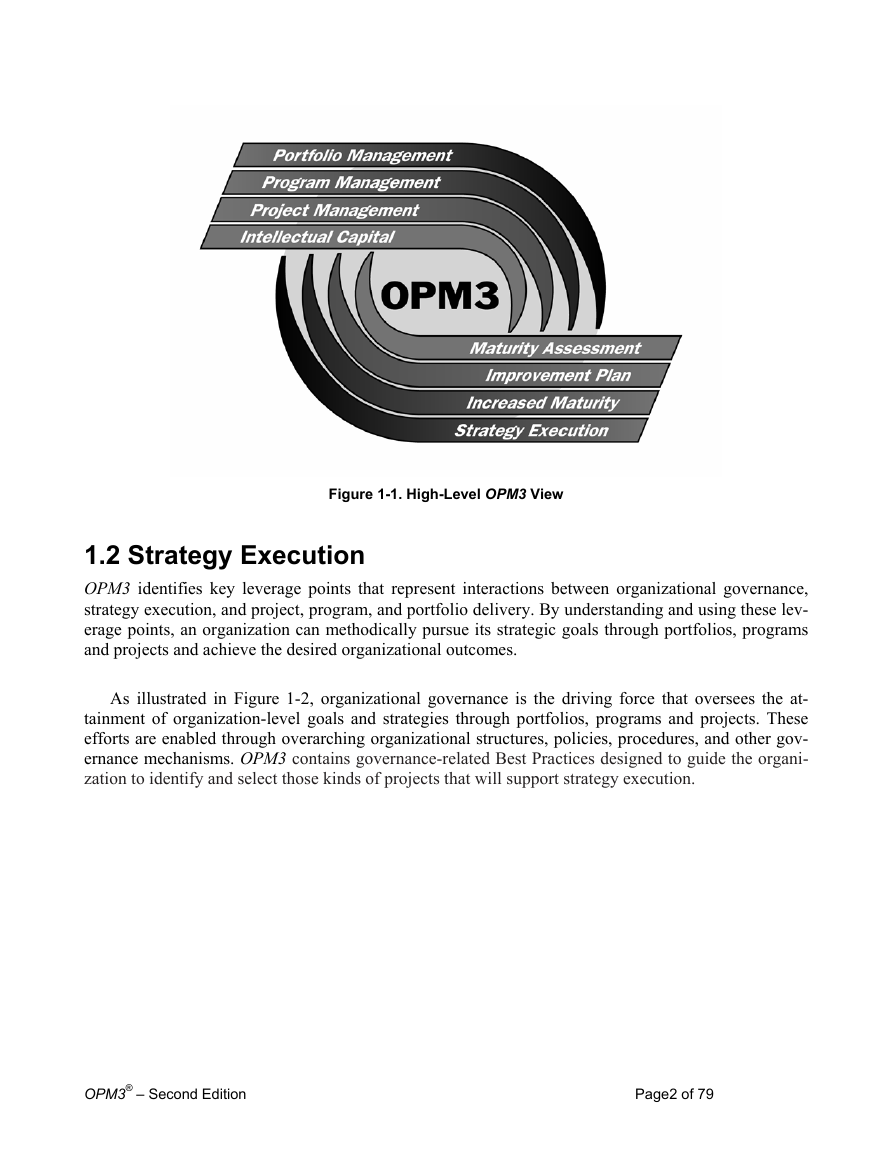
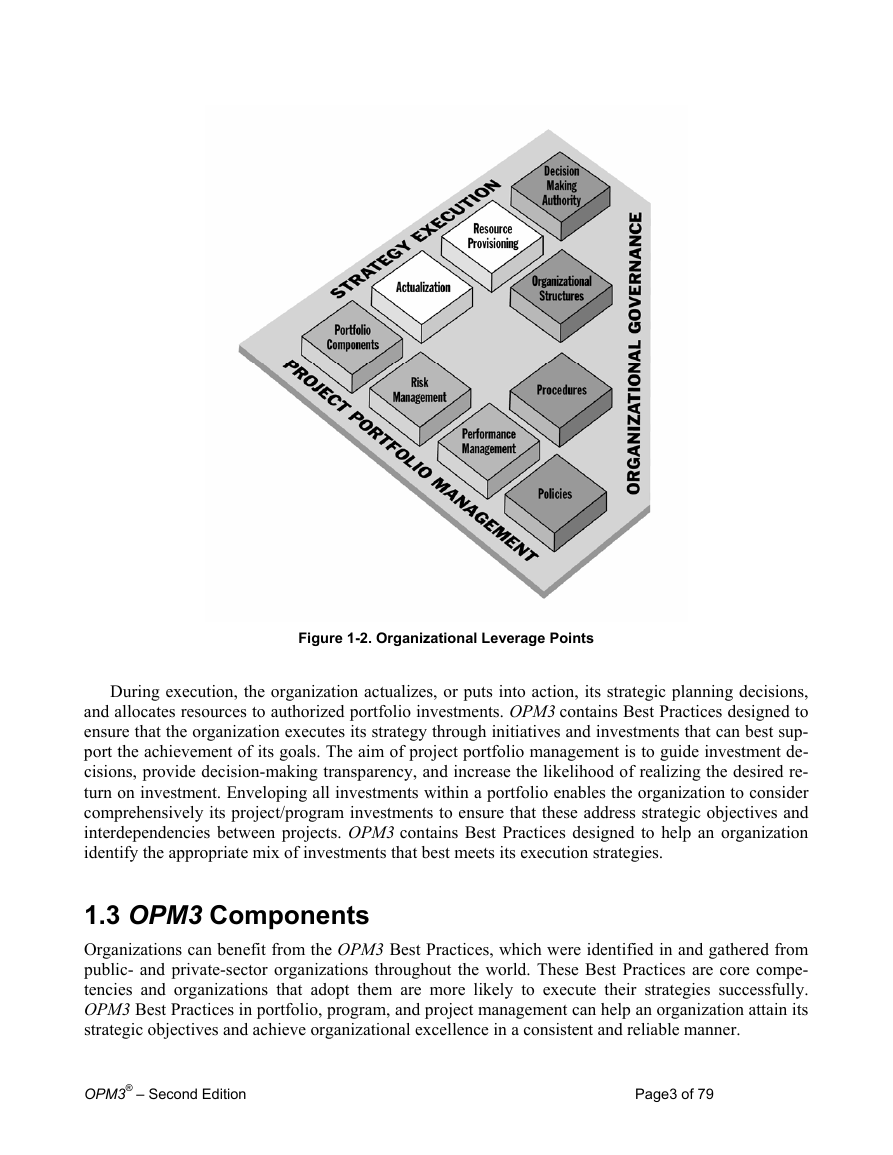
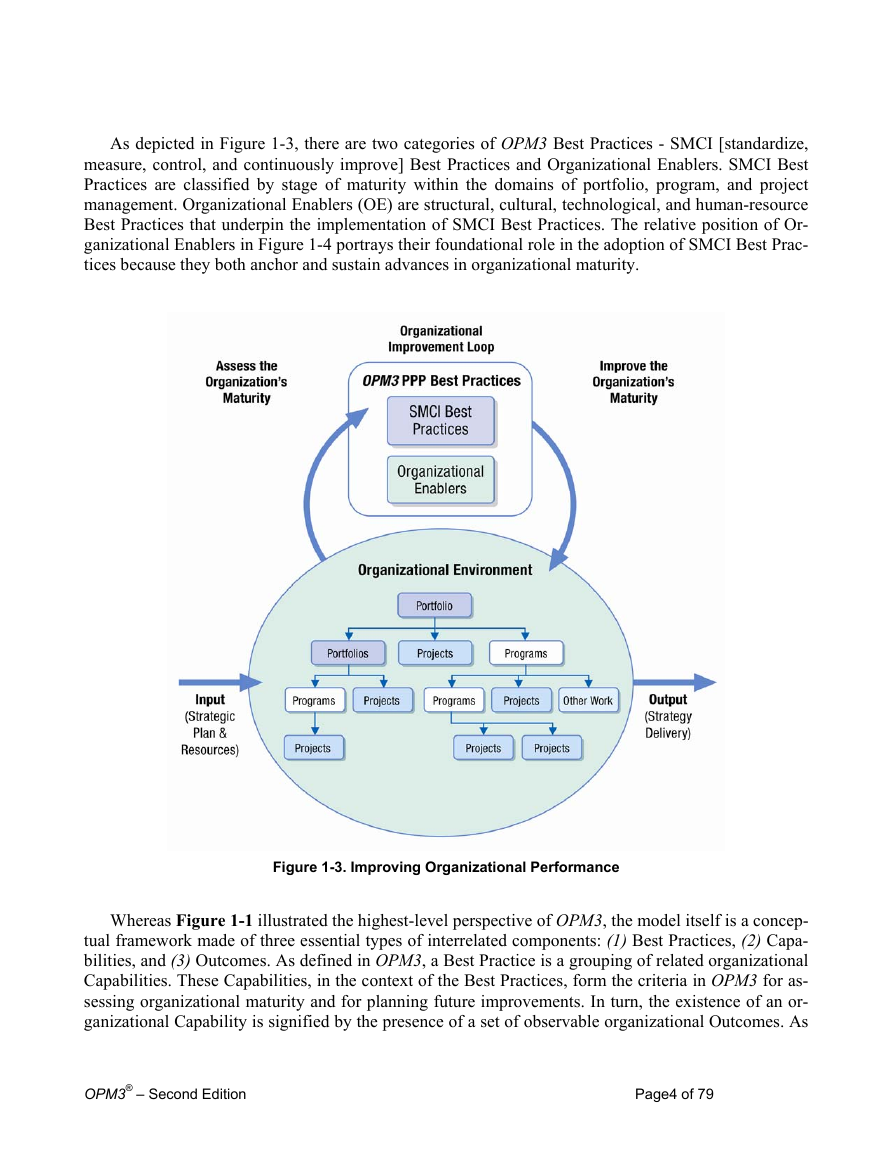

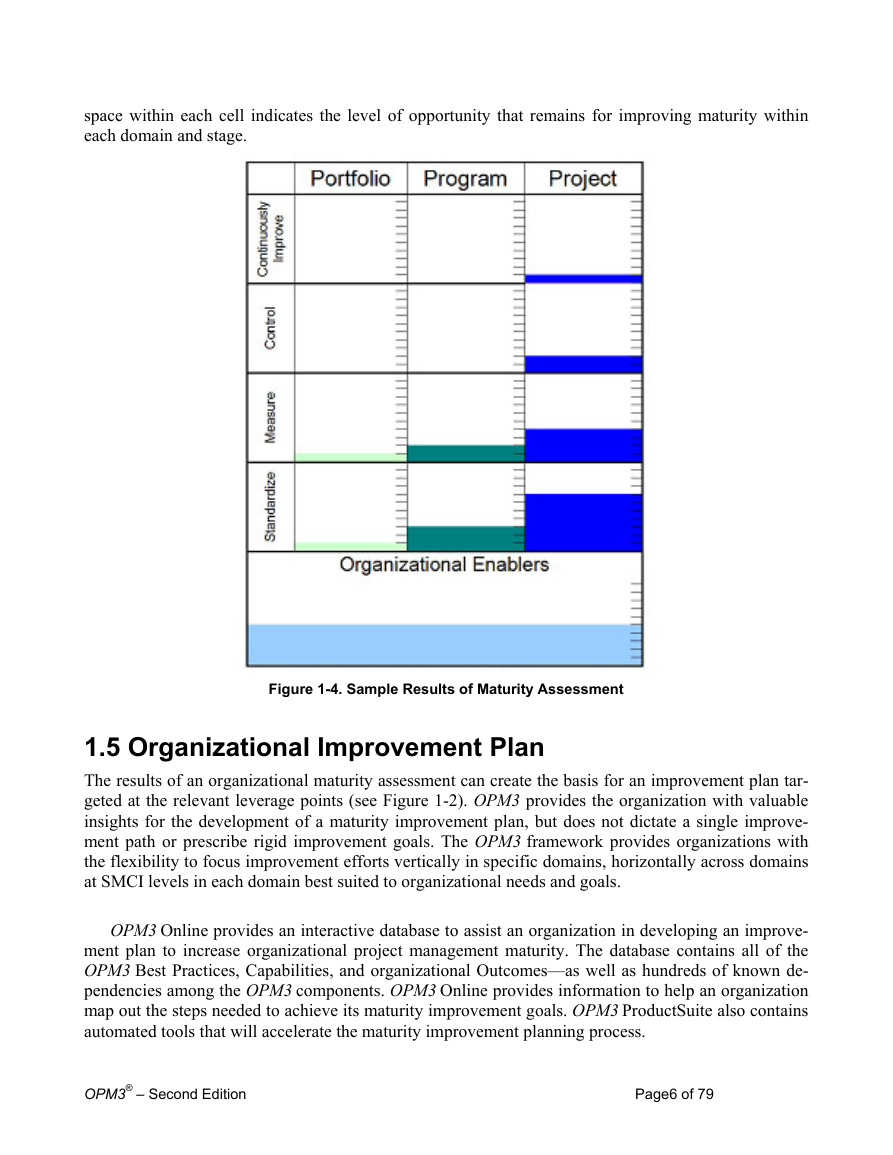
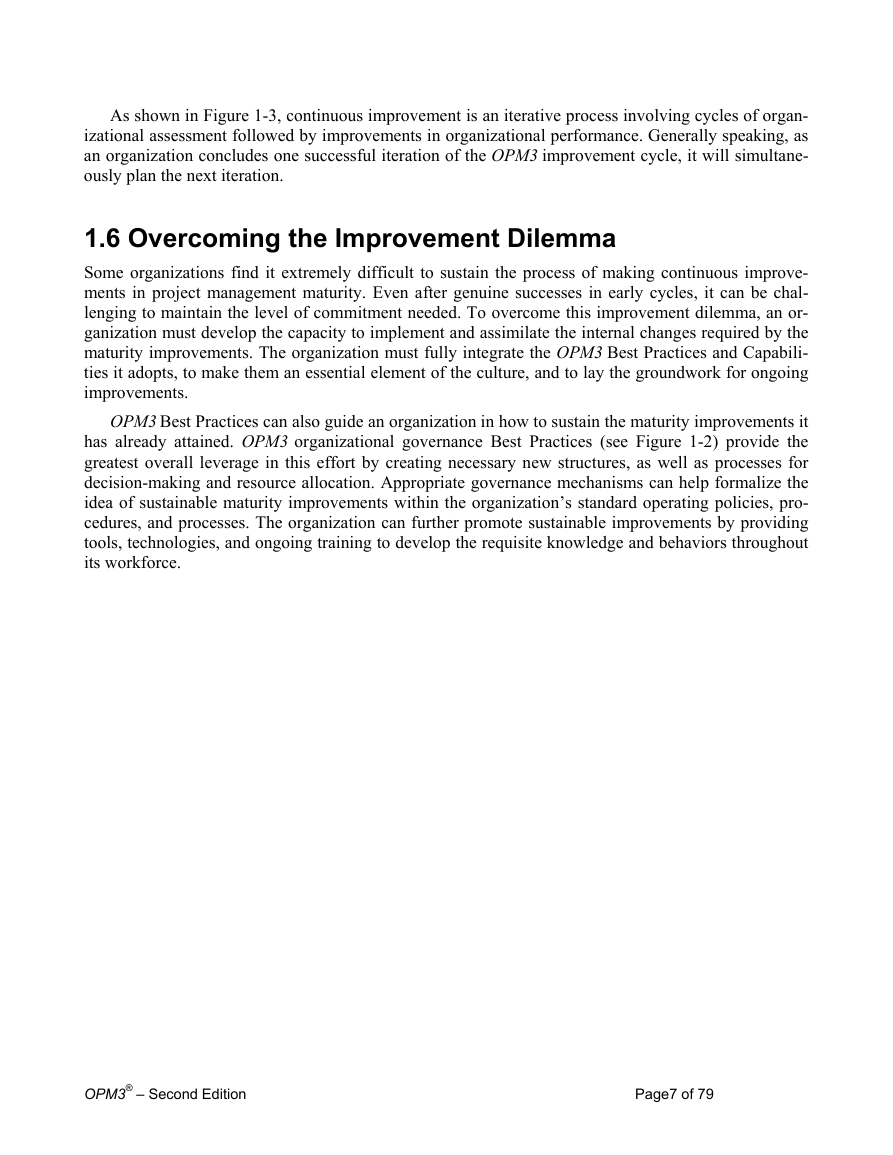
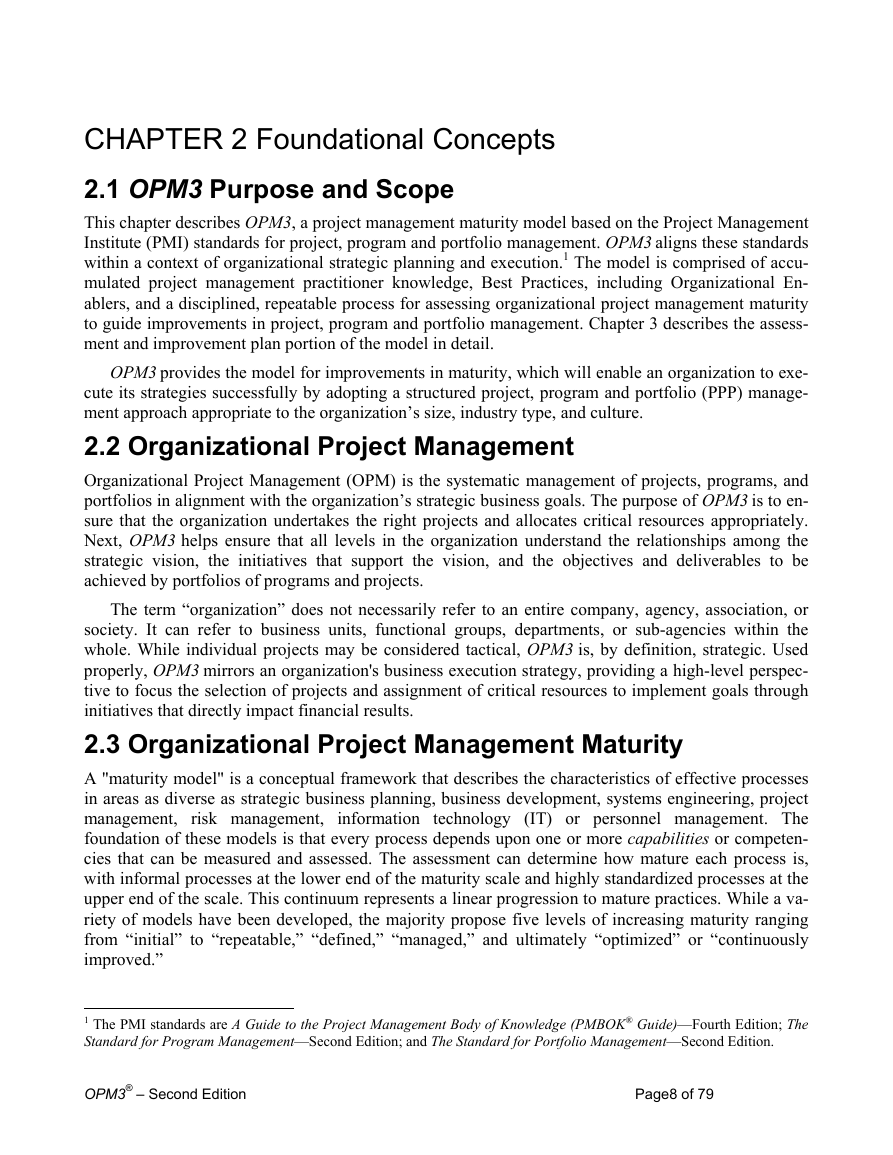








 2023年江西萍乡中考道德与法治真题及答案.doc
2023年江西萍乡中考道德与法治真题及答案.doc 2012年重庆南川中考生物真题及答案.doc
2012年重庆南川中考生物真题及答案.doc 2013年江西师范大学地理学综合及文艺理论基础考研真题.doc
2013年江西师范大学地理学综合及文艺理论基础考研真题.doc 2020年四川甘孜小升初语文真题及答案I卷.doc
2020年四川甘孜小升初语文真题及答案I卷.doc 2020年注册岩土工程师专业基础考试真题及答案.doc
2020年注册岩土工程师专业基础考试真题及答案.doc 2023-2024学年福建省厦门市九年级上学期数学月考试题及答案.doc
2023-2024学年福建省厦门市九年级上学期数学月考试题及答案.doc 2021-2022学年辽宁省沈阳市大东区九年级上学期语文期末试题及答案.doc
2021-2022学年辽宁省沈阳市大东区九年级上学期语文期末试题及答案.doc 2022-2023学年北京东城区初三第一学期物理期末试卷及答案.doc
2022-2023学年北京东城区初三第一学期物理期末试卷及答案.doc 2018上半年江西教师资格初中地理学科知识与教学能力真题及答案.doc
2018上半年江西教师资格初中地理学科知识与教学能力真题及答案.doc 2012年河北国家公务员申论考试真题及答案-省级.doc
2012年河北国家公务员申论考试真题及答案-省级.doc 2020-2021学年江苏省扬州市江都区邵樊片九年级上学期数学第一次质量检测试题及答案.doc
2020-2021学年江苏省扬州市江都区邵樊片九年级上学期数学第一次质量检测试题及答案.doc 2022下半年黑龙江教师资格证中学综合素质真题及答案.doc
2022下半年黑龙江教师资格证中学综合素质真题及答案.doc